Last updated on May 1st, 2024 at 05:04 pm
Yoga is a group of asana(Poses), mudars, breathing exercises, and meditation to help the body and mind in self-conscience, evaluate, revive, and freedom from suffering, best practice building connection between body, mind, and soul. An ancient art improving physical and mental health, yoga offers many physical exercises, poses, breathing, and meditation techniques for health and well-being, working on the total human system like mind, body, emotion, and breath. Yoga can also be impactful on your mental health, reduce stress, and improve mental health.
Stress is quite a normal human condition that happens to everyone, and is affected by stressful situations, stress can be both physical and mental. Stress symptoms and causes vary from person to person, due to present lifestyle changes, financial responsibility, workload, relationships, and personal and professional life we feel stressed and emotionally unstable many times which is quite normal, this is a phase of life that can be short or long-term (chronic).
But don’t worry, yoga is a perfect stress buster, many yoga poses and breathing exercises help you reduce stress, and promote relaxation. Regularly practicing yoga promotes your mental health and encourages mindfulness it is capable of maintaining a more calm, focused, balanced, and healthy lifestyle. In this article, we suggest some effective yoga poses and breathing exercises to keep your body and mind healthy and give you stress relief.
Connection Between Yoga And Stress Relief
Yoga is an ancient art and science, it offers many yoga poses (asanas), mudras, breathing, exercise, concentration on meditation, and mindful breathing to help reduce stress, anxiety, and depression. It also improves blood circulation and supplies more oxygen to the brain cells, yoga has numerous benefits in helping lower blood pressure, improve lung capacity, and balance hormones. Yoga boosts hormone production and endocannabinoids that promote positive feelings, calmness, and happiness and help you in stress management and emotional distress.
Yoga is a collection of poses, meditation, and breathing exercises that can help in stress management. These posture and breathing techniques relax your body and mind by reducing unwanted thoughts, overthinking, and stress, and focusing on mindfulness. Also, meditation has lots of benefits for improving mental health, reducing anxiety for improving mental health, reducing anxiety and its symptoms of stress, panic attacks, heart diseases, and agoraphobia, and also helping to reduce blood pressure and insomnia.
Benefits Of Yoga In Stress Relief
- Improve mental well-being
- Create mental clarity and calm
- Increase concentration and focus
- Reduce cortisol levels, promote relaxation
- Reduce mood swings and improve mood
- Improve sleep cycle.
Best Yoga Poses(Asanas) For Stress Relief
1. Child Pose

How To Do Child’s Pose
- Start by kneeling on your yoga mat with your knees hip-width apart.
- Sit back on your heels and bring your big toes together, allowing your knees to widen slightly.
- Exhale and lower your torso forward, resting your forehead on the mat.
- Extend your arms forward or alongside your body, palms facing up, and relax your shoulders.
- Allow your chest to rest on or between your thighs, and let your belly soften as you breathe deeply.
- Press your hips back towards your heels to deepen the stretch in your lower back and hips.
- Hold the pose for 1 to 3 minutes, or longer if comfortable, breathing deeply and surrendering to the pose.
- To release, gently walk your hands back towards your body and slowly roll up to a seated position.
Muscles Worked
- Back
- Shoulders
- Hips
- Thighs And Legs
2. Forward Bend Pose
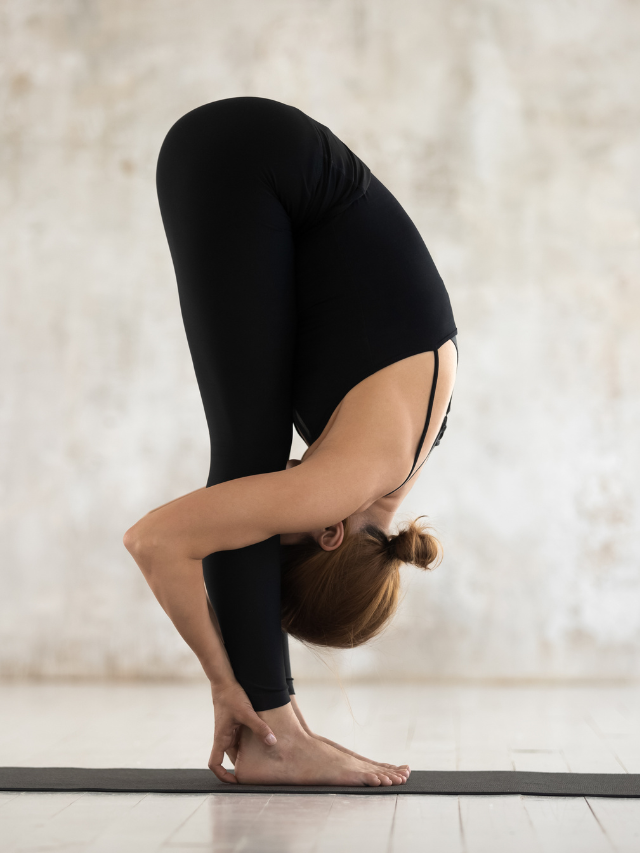
How To Do Forward Bend Pose
- Stand up straight with your feet hip-width apart.
- Take a deep breath in.
- As you exhale, bend forward from your hips.
- Keep your back straight and let your arms hang down.
- Bend your knees slightly to avoid straining your back.
- Relax your neck and let your head hang.
- Hold for 30 seconds to 1 minute while breathing slowly.
- To come up, inhale, and slowly rise back to standing.
Muscles Worked
- Hamstrings
- Lower back
- Calves
- Spine
- Shoulders
- Abdominals
3. Easy Pose(Sukhasana)

How To Do Easy Pose(Sukhasana)
- Sit on the floor with your legs crossed, left shin in front of right.
- Place your hands on your knees.
- Straighten your spine and relax your shoulders.
- Breathe deeply and close your eyes if comfortable.
- Hold for 1-5 minutes, focusing on your breath.
- To release, uncross your legs and stretch them out.
Muscles Worked
- Core muscles (abdominals)
- Back Muscles
- Hip Muscles
- Thigh Muscles
- Calf Muscles
4. Eagle Pose

How To Do Eagle Pose
- Stand up straight with your arms by your sides.
- Cross your right thigh over your left thigh.
- Bend your elbows and cross your left arm over your right arm in front of you.
- Bring your palms together if you can, or press the backs of your hands together.
- Sink your hips like you’re sitting in a chair.
- Hold for 15-30 seconds while breathing deeply.
- Repeat on the other side.
Muscles Worked
- Leg Muscles
- Arm Muscles
- Back Muscles
- Core Muscles
- Hip Muscles
5. Bridge Pose

How To Do Bridge Pose
- Lie on your back with your knees bent and feet flat.
- Lift your hips towards the ceiling.
- Press into your feet and arms to lift higher.
- Hold for a few breaths.
- Slowly lower back down.
Muscles Worked
- Back
- Glutes
- Hamstrings
- Core
- Hip Flexors
6. Triangle Pose
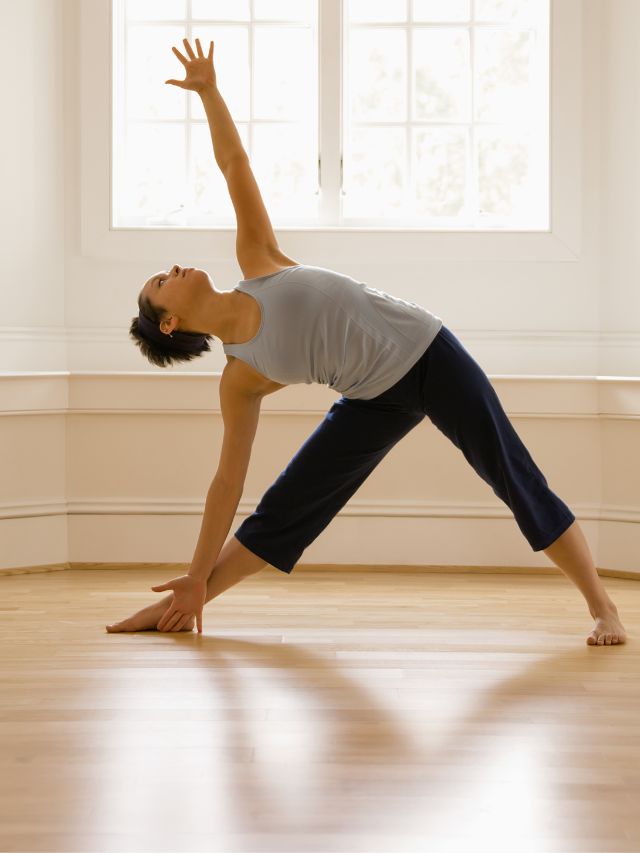
How To Do Triangle Pose
- Stand with feet wide apart.
- Turn right foot out, left foot slightly in.
- Stretch arms out to the sides.
- Reach right hand down to the shin, ankle, or floor.
- Extend left arm up, and look up.
- Hold for a few breaths.
- Switch sides.
Muscles Worked
- Legs
- Core Muscles
- Side Body
- Shoulders and Arms
7. Cat-Cow Pose
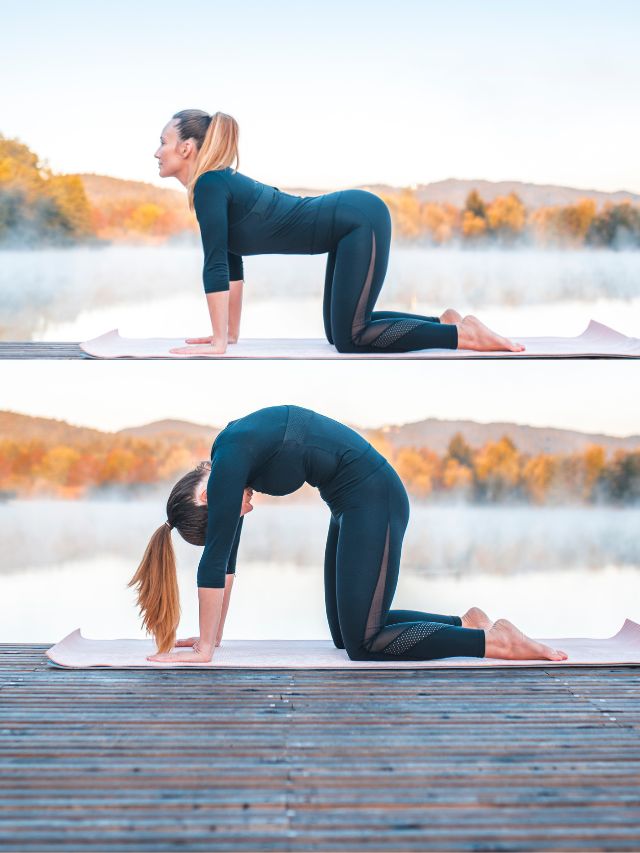
How To Do Cat Cow Pose
- Start on your hands and knees.
- Inhale, arch your back and lift your chest (Cow Pose).
- Exhale, round your back, and tuck your chin to your chest (Cat Pose).
- Repeat, flowing with your breath.
- Do several rounds, focusing on the movement of your spine.
- To finish, return to a neutral tabletop position.
Muscles Worked
- Spinal muscles
- Abdominal muscles
- Shoulder muscles
- Neck muscles
8. Legs Up The Wall Pose

How To Do Legs Up The Wall Pose
- Sit next to a wall.
- Lie on your back and swing your legs up the wall.
- Scoot your buttocks close to the wall.
- Relax your arms and breathe deeply.
- Hold for 5-15 minutes.
- To come out, bend your knees and roll to the side.
Muscles Worked
- Hamstrings
- Glutes
- Abdominals
- Hip flexors
9. Corpse Pose

How To Do Corpse Pose
- Lie flat on your back.
- Let your arms rest by your sides, palms facing up.
- Close your eyes.
- Relax your body completely.
- Breathe deeply and slowly.
- Stay in this position for 5-15 minutes.
- When you’re ready to finish, slowly return to a seated position.
Muscles Worked
- Abdominals
- Muscles of the Chest and Shoulders
- Hip flexors
Best Breathing Excercise(Pranayamas) For Stress Relief
1. Kapalbahti Pranayam
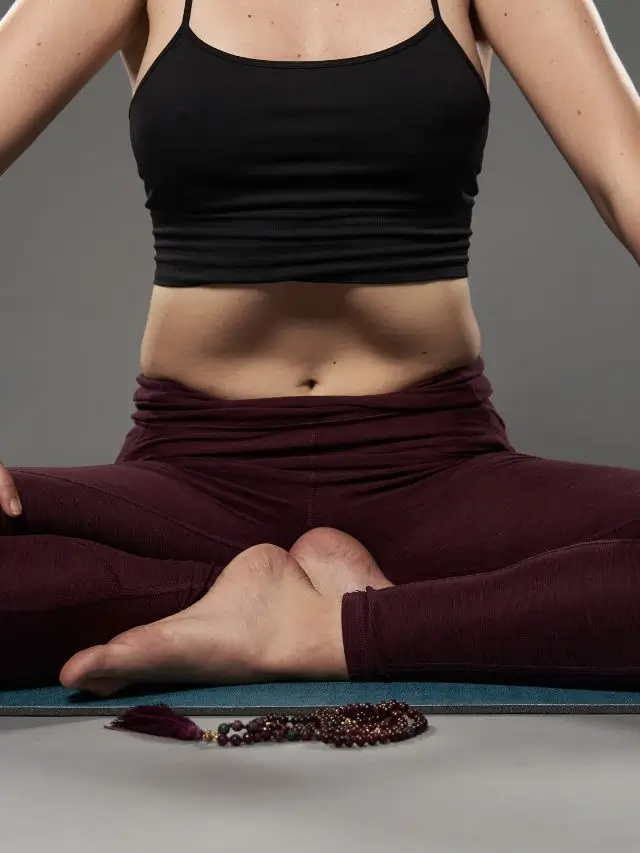
How To Do Kapalbhati Pranayam
- Sit comfortably with your back straight.
- Place your hands on your knees.
- Take a deep breath through your nose.
- Exhale forcefully through your nose, pulling your belly in.
- Let the inhale happen naturally.
- Repeat this breathing pattern, focusing on the forceful exhales.
- Start slowly and gradually increase the speed.
- Aim for 20-30 rounds.
- Take a few deep breaths to return to normal.
2. Bhramari Pranayam
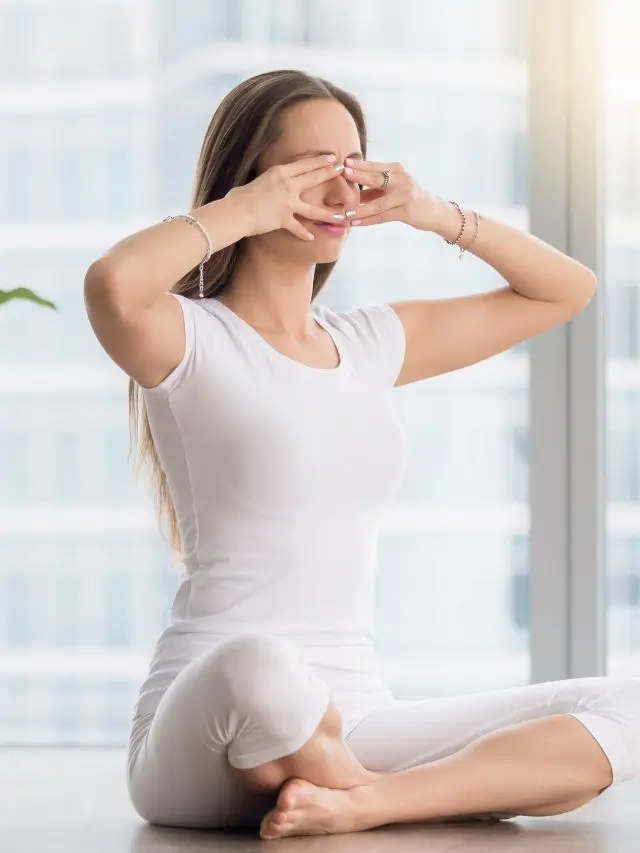
How To Do Bhramari Pranayam
- Sit comfortably with your back straight.
- Close your eyes and take a deep breath.
- Use your thumbs to close your ears gently.
- Inhale deeply through your nose.
- As you exhale, make a humming sound like a bee.
- Feel the vibration in your head and chest.
- Repeat for several rounds at your own pace.
- When finished, release your ears and take a few natural breaths.
3. Lion’s Breath
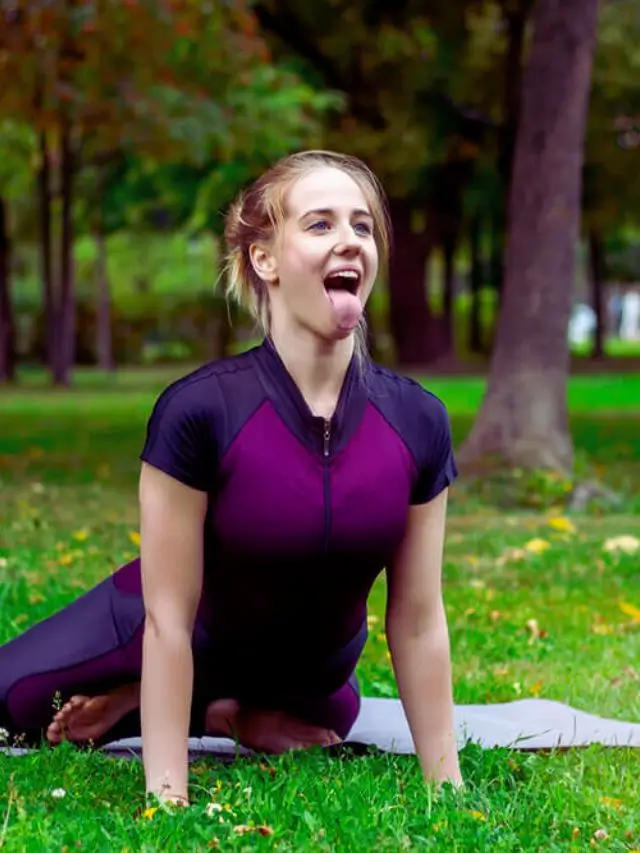
How To Do Lion Breath
- Sit comfortably with your back straight.
- Take a deep breath through your nose.
- As you exhale forcefully through your mouth, stick out your tongue and make a “ha” sound.
- Open your eyes wide and look upwards.
- Repeat a few times, taking deep breaths in between.
- Relax and return to normal breathing.
4. Ujjayi Pranayam

How To Do Ujjayi Pranayam
- Sit comfortably with your back straight.
- Close your eyes and take deep breaths through your nose.
- Slightly constrict the back of your throat to make a soft, ocean-like sound as you breathe.
- Inhale and exhale slowly and steadily, focusing on the sound of your breath.
- Continue for a few minutes, then return to normal breathing.
Physical Symptoms Of Stress
- Sweaty Plam
- Chest pain
- Shaking hands and legs
- Low energy
- Headaches
- Difficulty In Breathing
- Heartburn
- Constipation
- Dry mouth
- Frequent Cold and Cough
- Loss Sexual Desire
- Hypertension
- Difficulty in Sleeping
- Heart Racing
Mental Symptoms Of Stress
- Depression
- Anxiety
- Lack Of Focus
- Mood Swings
- Loneliness
- Suicidal Thoughts
- Worrying
- Fobia
- Racing Thoughts
- Social Awkwardness
- Tention
- Overthinking
- Feel Neglected
Frequently Asked Questions
Q1. Which type of yoga is best for stress relief?
Ans. Feeling stressed? Breathe easy! These 5 yoga poses are perfect for beginners to unwind:
1. Child’s Pose: Curl up like a comfy ball, rest your forehead on the ground, and breathe deeply.
2. Downward-Facing Dog: Make an upside-down V with your body, stretch your back, and boost circulation.
3. Corpse Pose: Lie flat on your back, relax your whole body, and simply breathe.
4. Standing Forward Fold: Hinge at your hips, reach for the ground (or your shins!), and release tension.
5. Cat-Cow Stretch: Arch your back like a cat, then round it like a cow, for gentle spinal movement.
Q2. How does Yoga help reduce stress?
Ans. Yoga tackles stress at its root by promoting relaxation, the body’s natural antidote to stress. It works on three key areas impacted by stress:
Physical Body: Gentle stretches in yoga poses (asanas) release muscle tension, a common stress symptom. Yoga also improves flexibility, reducing pain and discomfort that can contribute to stress.
Mind: Yoga incorporates mindfulness practices like focusing on breath, which quiets the mind and reduces racing thoughts often associated with stress.
Breath: Deep, controlled breathing techniques (pranayama) in yoga activate the parasympathetic nervous system, promoting relaxation and countering the “fight-or-flight” response triggered by stress.
Q3. Which asanas are best for improving mental health?
Ans. Here are 5 key asanas:
Child’s Pose (Balasana): Fosters relaxation and security, easing anxiety.
Downward-Facing Dog (Adho Mukha Svanasana): Energizes, boosts mood, and combats fatigue.
Bridge Pose (Setu Bandha Sarvangasana): Promotes relaxation, reduces anxiety, and improves sleep.
Legs-up-the-Wall Pose (Viparita Karani): Enhances relaxation, circulation, and alleviates anxiety and depression symptoms.
Corpse Pose (Savasana): The ultimate stress reliever, reducing stress hormones and promoting better sleep.
These poses target physical tension, improve mood, and enhance relaxation, all contributing to better mental health.
Q4. Which pranayam reduces stress?
Ans. Nadi Shodhana
Nadi Shodhana, also known as alternate nostril breathing, is a powerful pranayama technique for stress reduction. Here’s why:
Slows Breath Rate: It promotes slower, deeper breaths, countering the rapid, shallow breathing associated with stress.
Activates Relaxation Response: By calming the nervous system, it triggers the body’s natural relaxation response, alleviating stress.
Reduces Anxiety: Research shows Nadi Shodhana effectively reduces anxiety levels.
Conclusion
Yoga meditation and pranayams are the best way to relief from a stressful life, and working on your physical and mental well-being helps reduce stress, retain energy, and enhance your skills, It is an effective and sustainable way to calm your body & mind, yoga helps inbound your negative thoughts, the addition of yoga, meditation in your daily routine can help your mind calm and let go to stress, deep relaxation restore energy enhance your mental and physical relaxation, sleep quality and encourage mindfulness.
Watch Our YouTube Video
About The Author

Honey is a certified yoga instructor with training from Patanjali Yogpeeth, Haridwar. With four years of dedicated teaching experience, she specializes in using yoga to improve spinal health, build core strength, and help people find relief from chronic pain. Her mission is to make the transformative power of yoga accessible to everyone.




